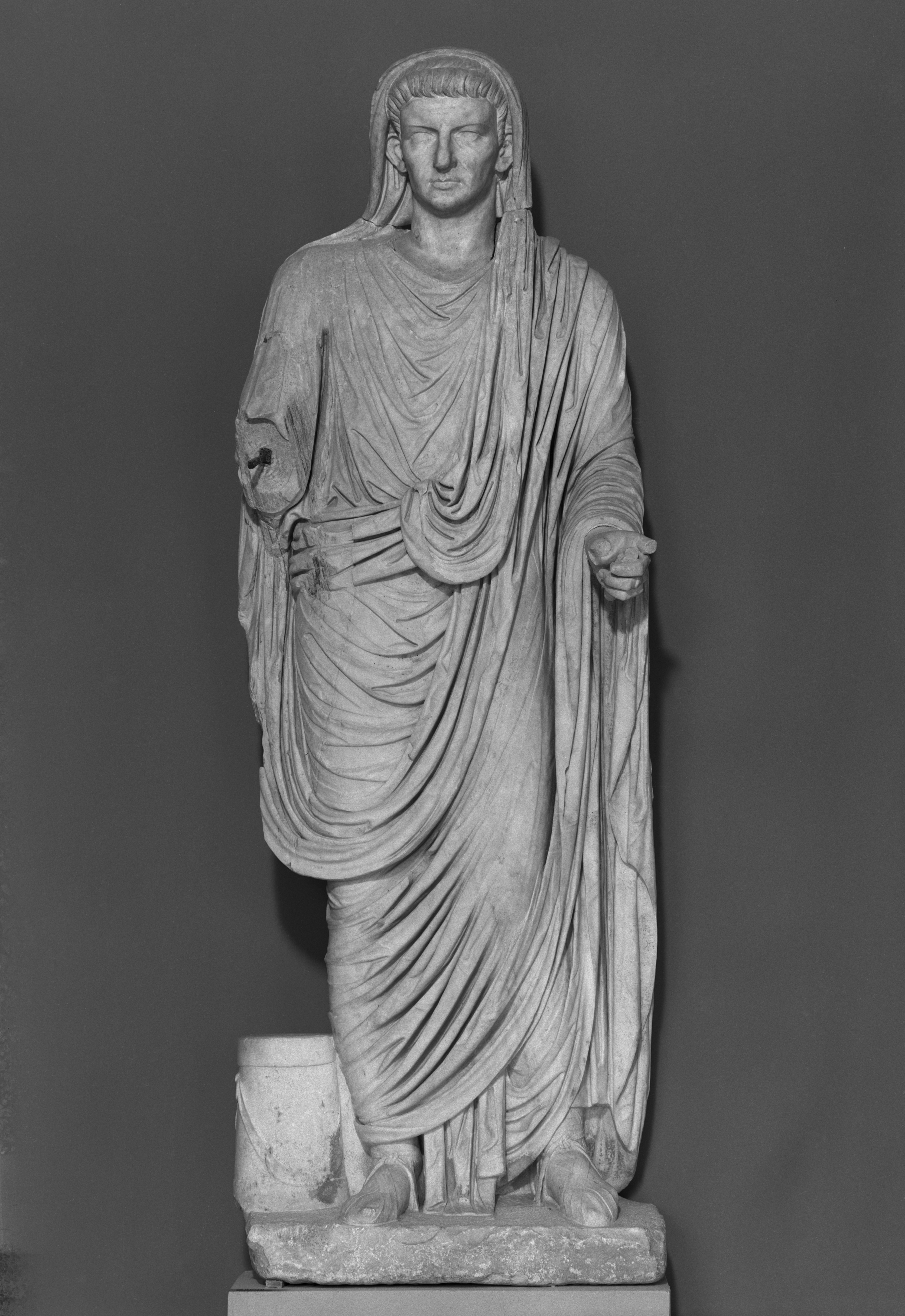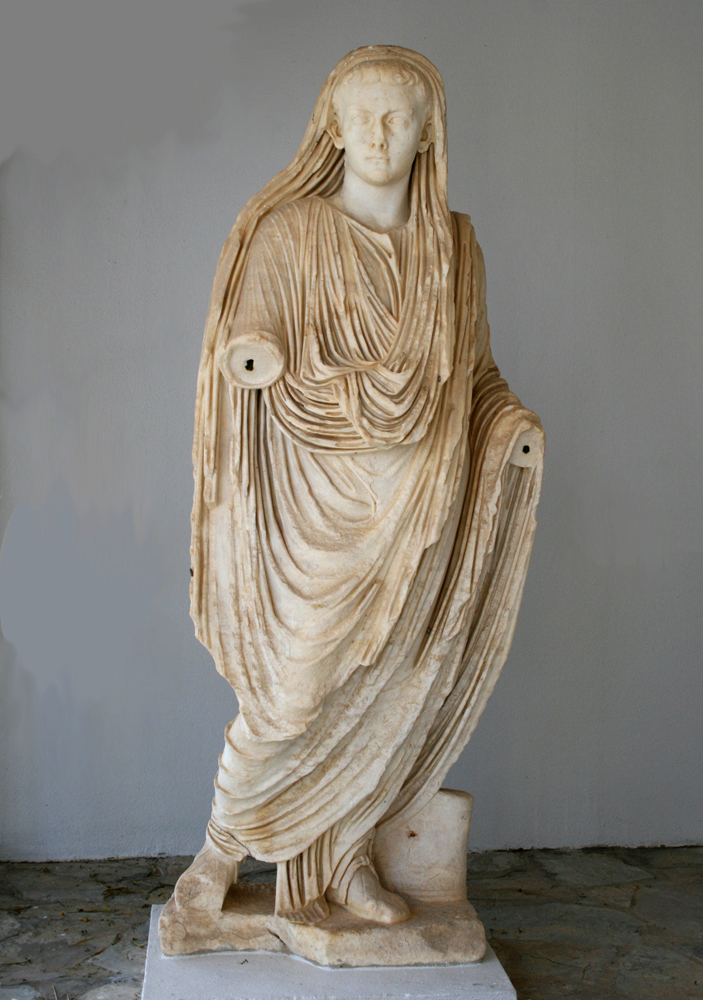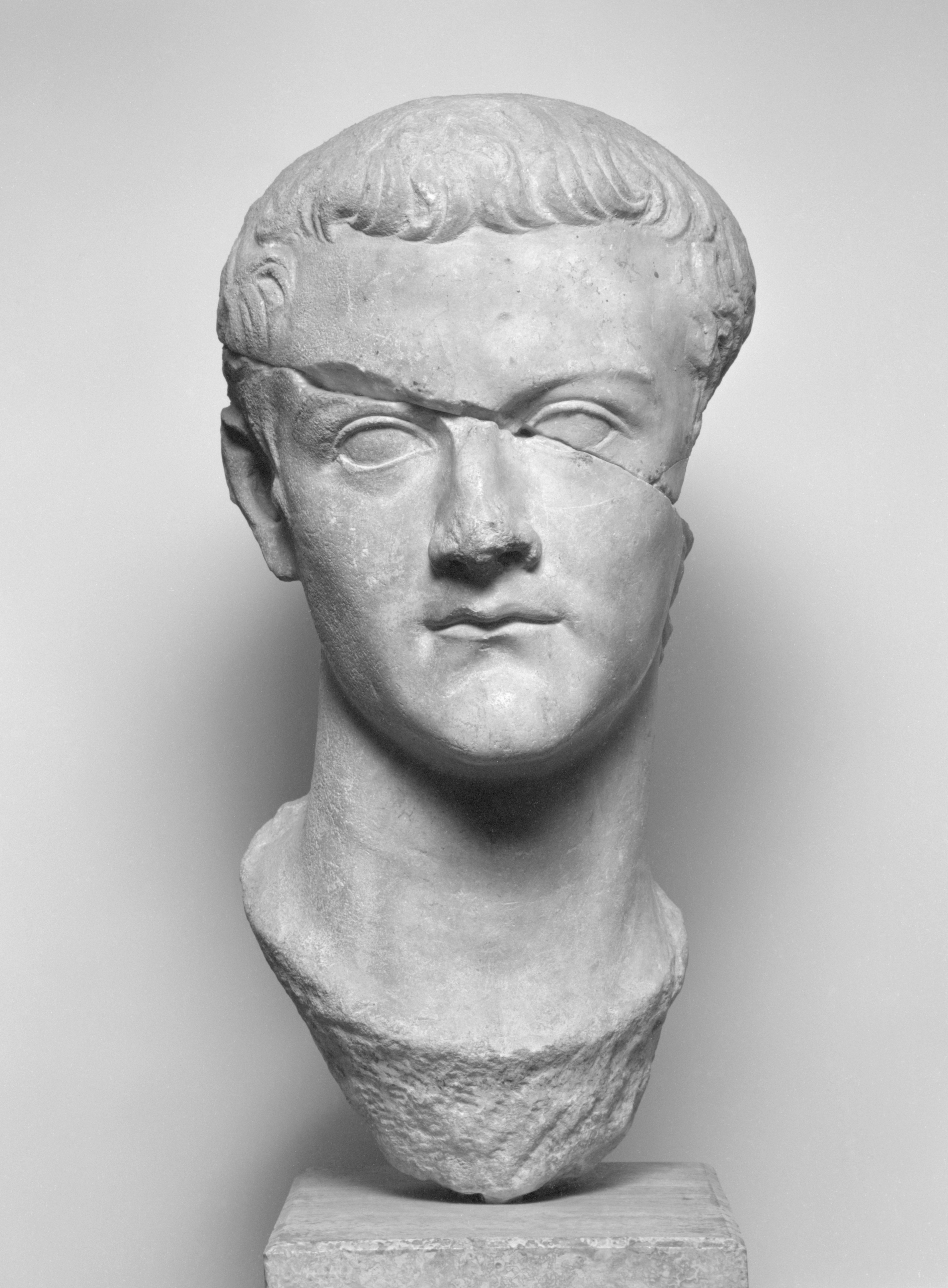| (Contribution jointly with Paolo Liverani) |
Reflections on the Typology and Context of the Richmond Caligula |
Jan Stubbe Østergaard |
My point of departure has just been given by Paolo Liverani in his presentation of the recently established facts concerning the when and where of the discovery of Richmond Caligula, and of the hypotheses on its context which these facts allow. I will periodically have to repeat some of what he had to say, so please bear with me.
To recapitulate, the statue was found in 1825 during the fragmentarily documented excavations at Bovillae directed by Luigi Poletti on lands belonging to Don Vincenzo Colonna. The find was made in the remains of a substantial Roman structure in which fragments of the fasti and acta of the Sodalium Augustalium were also found. In his Annales, Tacitus tells us that Tiberius established the priesthood of the Sodales Augustales after the death of Augustus and that it resided at Bovillae where a sacrarium to the Gens Iulia had been established. It is not known whether the magistri of the sodales had their own building, a schola, at Bovillae.[1]
It appears that as members of the imperial family the emperors became members of the Sodales by right, for Tiberius, his son Drusus, and his adoptive son had all been entered into their number at the foundation of the priesthood; Cassius Dio (59.7.1) tells us that Caligula and his sisters seated themselves among the Sodales in connection with the dedication in CE 37 of the Temple of Divus Augustus.
Having come thus far, we are faced with two very different but, of course, interconnected patterns of approach to an understanding of the why and wherefores of our Caligula – one of which, at least initially, moves ahead without relying too much on hypotheses, while the other is based on an hypothesis.
The first approach is hypercritical, dismissing the 1825 documentation as altogether too unreliable and thus forcing us to interpret the sculpture entirely on its immanent evidence. Here, at the outset, I choose the second approach in order to maintain a minimum of narrative flow in our joint presentation.
So, I accept the hypothesis presented by Liverani, namely that our Caligula and the fragments of the records of the Sodales Augustales were not only found together in Poletti's excavation, but did, in fact, originally belong together in a structure of considerable size situated at the urban centre of Bovillae; furthermore, I accept that this structure was connected with the cult of the Gens Iulia, either as a schola for the priesthood or the sacrarium of the cult (or possibly serving both functions).
This hypothesis raises a number of questions, the answers to which may serve to weaken or substantiate the hypothesis. These questions deal not least with the issue of parallels for similar material originating from similar structures.
Let us first ask whether we have any sort of evidence of imperial portrait statues set up in connection with the sacrarium or a possible schola of the Sodales Augustales at Bovillae (or anywhere else for that matter). The answer is a definite yes, for, as Liverani notes, Tacitus tells us that a statue (effigies) of Divus Augustus was set up in connection with the establishment of sacrarium.[2]
Next, do we have any evidence of the Sodales Augustales dedicating imperial portrait statues anywhere else? Here, the answer is also yes, for the Sodales set up a statue of Germanicus near the Ara Providentiae Augustae on the Campus Agrippae in Rome.[3]
And then: Do we have any concrete evidence that a sacrarium devoted to the cults overseen by the Sodales Augustales, or by the sodalicia later established for the cult of the gentes of following dynasties, must necessarily have contained portrait statues of the emperors of the relevant gentes, and if yes, do we furthermore have any evidence of the statue type likely to have been chosen for such statues? Tacitus does not say, in so many words, that the effigies of Divus Augustus set up at Bovillae were actually at or in the sacrarium, but this is certainly what he implies. I have not found any other instances for later sodalicia, although a more thorough examination of the literature might change this picture.[4] At present, we have found no direct information on the type of portrait statue chosen for this kind of context. This allows us the negative conclusion that nothing so speaks against our Caligula having originally stood in the sacrarium at Bovillae.
Let us, therefore, pose questions of a different order, questions pertaining to the statue itself, in the hope of throwing light on the nature of our statue of Caligula and its original context at Bovillae.
Allow me to briefly recall the main features of the sculpture (click here for photos). It is a slightly over life-size, togate statue on foot (a statua pedester[5]), the toga being of the type with u-shaped umbo in a form seen in the Julio-Claudian period.[6] Underneath the toga, the emperor wears a tunic of the tunica laticlavia type, as revealed by the minimal but definite remains of a purple color in the vertical fold recesses on the right side of the chest, indicating the original presence of a latus clavus (cf. the contribution by Mark Abbe. On this evidence, the toga may have been a toga praetexta or the triumphal toga picta (Boschung 2002, 192-93).
Furthermore, we must take note of the fact that the statue is monolithic, that is carved out of a single block of flawless, white marble (cf. the characterization by Mark Abbe in his contribution to this volume). The volume of the statue is fully three-dimensional, although the carving on the back is slightly less developed than that of the other views. The rendering of the back contrasts with many imperial portrait sculptures whose backs are virtually flat and cursorily carved (figs. 1, 2).

|
| Fig. 1 Portrait statue of Caligula, recarved as Claudius. From the Basilica at Veleia. Parma, Museo Archeologico Nazionale, inv. 834. Marble. H. 221.0. |

|
| Fig. 2 As fig. 1, Right profile. |
On the basis of the photographs, I would rate the quality of the carving as extremely high on the front and of basically high quality on the back, though clearly with less finesse in the details. These observations, in their turn, raise a number of questions regarding parallels.
We may start out by looking for other monolithic portrait statues of Caligula of the same type and size. There is just one (fig. 3), now in Trieste, which has been recut in more recent times from a statue fragment into a bust. Its original context is not known (Boschung 1989, 109 no. 9).

|
| Fig. 3 Bust of Caligula, recut in modern times from a statue. From Aenona? Trieste, Museo Civico, inv. 2177. Marble. H. 52.0. |
At least two[7] other complete and monolithic statues have come down to us, both capite velato: one from the agora at Gortyn, Crete (fig. 4) (Goette 1989, 119 no. Ba 105; Boschung 1989, 109 no. 8), the other a Caligula portrait statue altered to Claudius [Fig. 5] from the Julio-Claudian group in the basilica at Veleia, Italy ( Saletti 1968, 45-49 no. 10; Goette 1989, 119 no. Ba 104; Boschung 1989, 97; Rose 1997, 121.123; Boschung 2002, 26 no. 2.9).

|
| Fig. 4 Portrait statue of Caligula, from the Agora of Gortyn. Gortyn, Antiquarium. Marble. H. 204.0. |
Not a very helpful haul, and one that also draws a blank as far as direct parallels for a Caligula of our type as part of an imperial statue group. The Caligula/Claudius capite velato from Veleia, is the only full-size portrait statue to come from a well-documented Julio-Claudian imperial statue group. A head of Caligula for insertion in a togatus capite velato at Iesi (Aesis), Italy (fig. 5) probably belongs with similar heads of Augustus and Tiberius; from the agora at Gortyn, we have a Caligula head for insertion, also from a togatus capite velato, with a similar head of Tiberius, and with insertion heads of Livia and Caius Caesar(?) (Boschung 1989, 97-98; Rose 1997, 81 (Iesi), 152-153 (Gortyn); Boschung 2002, 136-137 (Iesi), 62-63 (Gortyn)).

|
| Fig. 5 Caligula, head for insertion in toga statue capite velato. Jesi, Palazzo della Signoria. Marble. H. 34.0. |
It might conceivably be worthwhile to widen the field of search for comparanda to include Julio-Claudian togati not capite velato, including small formats and coins.[8] As it is, we are really not much the wiser as to the why and wherefores of the Richmond Caligula. But at least there is an indication of what we could usefully do: it would, for example, be of interest to go through both literary and epigraphical sources on the search for any further indications of imperial portraits set up in connection with the sacraria and/or scholae of the cult of the imperial gentes in general and of the Gens Iulia in particular.
Needless to say, the hypothesis that our Caligula stood in the sacrarium or schola at Bovillae will make us turn every last sliver of an inscription from that area.[9] And since, for obvious reasons, we cannot rule out the presence at Bovillae of an imperial Julio-Claudian statue group, we should just as assiduously pursue any identifiable part of a portrait statue of that dynasty which may be even remotely connected with Bovillae and environs.
Of the statue types used for imperial portrait statues, a togatus like ours covers the "Republican" aspect, which were designed to show the emperor as civilis princeps, with associations of civilitas (Zanker 1979; Wallace-Hadrill 1982). A non capite velato togatus statue, such as the Richmond Caligula, characterizes the emperor as a Roman citizen cum magistrate, actively participating in the political processes of the "republic," as opposed to a capite velato togatus, which shows the emperor in the act of fulfilling priestly duties and thereby communicating to the viewer the virtue of pietas. As reconstructed (click here for photos), the pose of the Richmond Caligula is one of engagement, the right arm reaching into the viewer's space, as if performing in a public role. But there is a distance, an aloofness, which would have been physically emphasized by the fact that such statues were mounted on bases with an average height of a meter or more, meaning that as it was originally displayed, the Richmond Caligula would have achieved a total height of at least c. 3 meters.[10] No one would have encountered Caligula eye to eye.
The sculpture, thus, belongs within the framework of a complex system of visual communication which was a constitutive element of the Principate (V. d. Hoff 2009, 240). In this context, the original polychromy of the sculpture would have played a vital role (Goette 1989, 4-6, Boschung 1989, 89). The toga was color coded to signal the status of the wearer, whether as a person in the real world or as a statua in the just-as-active virtual sphere of sculpture.[11] In the case of the Richmond Caligula, we have the documented presence of ancient pigment on the tunic, allowing us to develop a number of hypotheses about the original polychromy.
It does not lie within my brief for the symposium to contribute to the discussion of which kind of toga our Caligula may have worn – the arguments that would support an interpretation of the toga as a toga praetexta or a toga picta/triumphalis/palmate could each comprise separate essays in themselves.[12]
I can, however, end this contribution with regard to the matter of the polychromy of the Richmond Caligula's toga by introducing the evidence of the Caligula-recut-as-Claudius from Veleia and the young togate Nero from the same group (fig. 1 and fig. 6).
| Fig. 6 Statue of Nero, from the Basilica at Veleia. Parma, Museo Archeologico Nazionale, inv. 826. Marble. H. 153.0. |
It is all too characteristic of the state of research on polychromy that only black and white images are available of these sculptures (at least in the literature); thus, there is no visual documentation of the fact that of all the portrait statues of Julio-Claudians to have come down to us, only these two and the Richmond Caligula have pigment preserved on their togas – or rather, to my knowledge, these are the only works on which traces of pigment have been reported.[13] Boschung's observations of the presence of pigment are tantalizing, and one would like to go right away to the museum in Parma with the appropriate equipment in order to compare the traces on the statues there with the findngs on the Richmond Caligula.
What Boschung's observation on the Parma statue really declare, however, is that we must start looking again at monuments we thought had already been thoroughly examined and documented in order to track their original color. This is both because we now have the means to identify traces of pigment that earlier generations could not see and in recognition of the fact that polychromy constitutes the fourth dimension of ancient sculpture, a dimension that is no less important to the understanding and appreciation of ancient sculptures than their physical presence in space.
Bibliography
Bollmann 1998
B. Bollmann, Römische Vereinshäuser. Untersuchungen zu den Scholae der römischen
Berufs-, Kult- und Augustalen-Kollegien in Italien, Mainz 1998.
Boschung 1989
Dietrich Boschung, Das römische Herrscherbild I 4. Die Bildnisse Caligulas (Berlin 1989).
Boschung 1993
Dietrich Boschung, Die Bildnistypen der iulisch-claudischen Kaiserfamilie: ein kritischer
Forschungsbericht, JRA 6, 1993, 39-89.
Boschung 1998
Dietrich Boschung in JRA 11, 1998, 526-528 (rec. Rose 1997).
Boschung 2002
Dietrich Boschung, Gens Augusta. Untersuchungen zu Aufstellung, Wirkung und Bedeutung der
Statuengruppen des julisch-claudischen Kaiserhauses (Mainz am Rhein 2002).
Estienne 2005
ThesCRA V (2005) 93-95 s.v. Sodales Titii, sodales Augustales (Claudiales), Flaviales (Titiales),
Hadrianales, Antoniniani (Veriani Marciani) (Sylvia Estienne).
Fejfer 2008
Jane Fejfer, Roman Portraits in Context (Berlin and New York 2008).
Gabelmann 1985
Hanns Gabelmann, Römische Kinder in toga praetexta, JdI 100, 497-541.
Goette 1989
Hans Rupprecht Goette, Studien zu römischen Togadarstellungen (Mainz am Rhein 1989).
Von der Hoff 2009
Ralf von der Hoff, Caligula. Zur visuellen Repräsentation eines römischen Kaisers. AA 2009, 239-263.
Højte 2005
Jacob Munk Højte, Roman Imperial Statue Bases (2005).
Rose 1997
Charles Brian Rose, Dynastic Commemoration and Imperial Portraiture in the Julio-Claudian Period (Cambridge
1997).
Saletti 1968
Cesare Saletti, Il ciclo statuario della basilica di Velleia (1968).
Varner 2004
Eric Varner, Mutilation and Transformation. Damnatio Memoriae and Roman Imperial Portraiture (2004).
Winterling 2003
Aloys Winterling, Caligula. Eine Biographie (Verlag C.H. Beck 2003).
Zanker 1979
P. Zanker, Prinzipat und Herrscherbild, Gymnasium 86, 1979, 354.
Footnotes
[1]I shall not repeat the references to the sources already provided above by Liverani in notes, but will add: On sacraria see ThesCRA IV (2005) 316 – 317 (Mario Torelli), on the Sodales Augustales see RE Suppl. VII (1940) 1219-1220 (H. Strasburger) and Estienne 2005; on scholae, ThesCRA IV (2005) 319 (Francesco Marcattili). Further research is needed on the archaeology of sacraria and scholae.
[2]Liverani note 21. We also have evidence that "simple" Augustales dedicated this kind of imperial portrait (see Rose 1997, 51 w. n. 2; Højte 2005, 181).
[3]As stated in the Senatus Consultum de Cn. Pisone patre, cf. AEpigr (1996) 885. For the ara: LTUR IV (2005) 165-166 (Mario Torelli).
[4]See above, n. 1.
[5]In contrast to, for example, a statua equester, cf. Cic. Phil. 9. 13.
[6]Goette 1989, 29ff. ("Type B") and 2ff. Goette designates the first century CE version of this type "Ba," and remarks on the Caligulan-Claudian versions. On imperial togate statues, see Fejfer 2008, 397-399, focusing entirely on the capite velato type. See also Boschung 2002, 192-93 on the toga for imperial portraits during the Principate.
[7]A thorough review of all Caligula's portraits, including those altered, might reveal additional heads from monolithic statues. One other example should be included here: the capite velato togatus recut as Claudius in the museum at Eleusis, inv. 5086: Goette 1989, 38-39 and 125 under no. Ba 248; Boschung 2002, 111 no. 36.2 (not in the list in Varner 2004, 229-35). See references to lists and updates in von der Hoff 2009, 244-245 w. n. 21 and 24.
[8]See, for example, the miniature bronze bust set on a globe, in Colchester (Boschung 1989, 114 no. 28); the sestertius with the adlocutio (Boschung 1989, 18-19. pl. C1), issued after September CE 37 but before March CE 38.
[9]Højte 2005 has already had a very careful look at imperial Roman statue bases.
[10]Cf. Abbe; Højte 2005, 28-34.
[11]Cf. Paolo Liverani, Reflections about color coding in Roman art, in Ph. Jockey (ed.), Les arts de la couleur en Grèce ancienne ... et ailleurs (Colloque Athènes École Française: 23 - 25 avril 2009), BCH Suppléments (forthcoming).
[12]The difference between these last three and the toga purpurea is not entirely clear to me.
[13]The first to notice, as far as I know: Boschung 2002, 26 to no. 2.9 (Caligula/Claudius) and 2.10 (Nero, "extensive"), 193 n. 1409 (not noted by Saletti 1968 in his otherwise exemplary publication).
Back to Papers
Copyright © 2009-13. Last updated: March 22, 2013.
The Digital Sculpture Project is an activity of the Virtual World Heritage Laboratory.